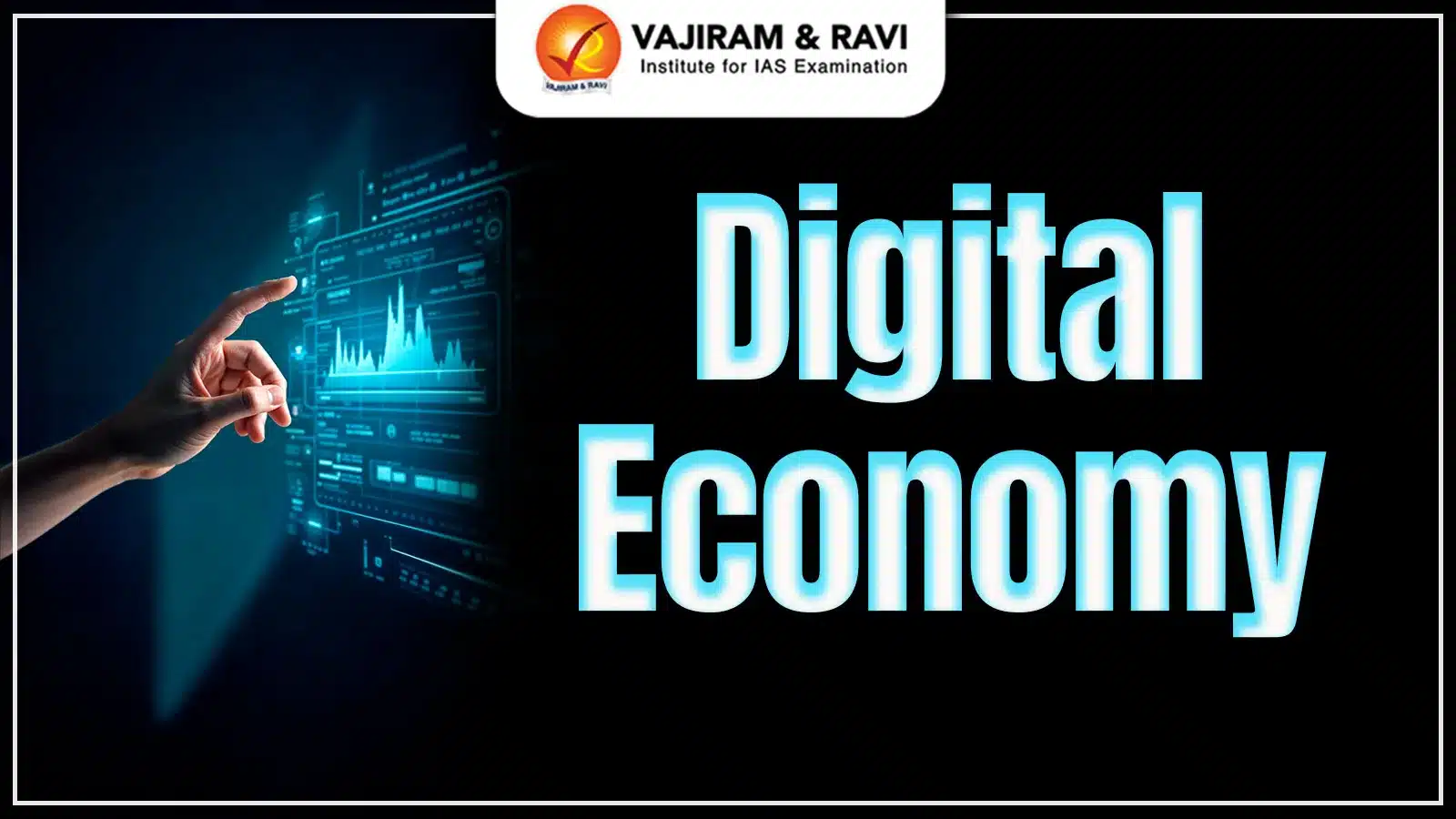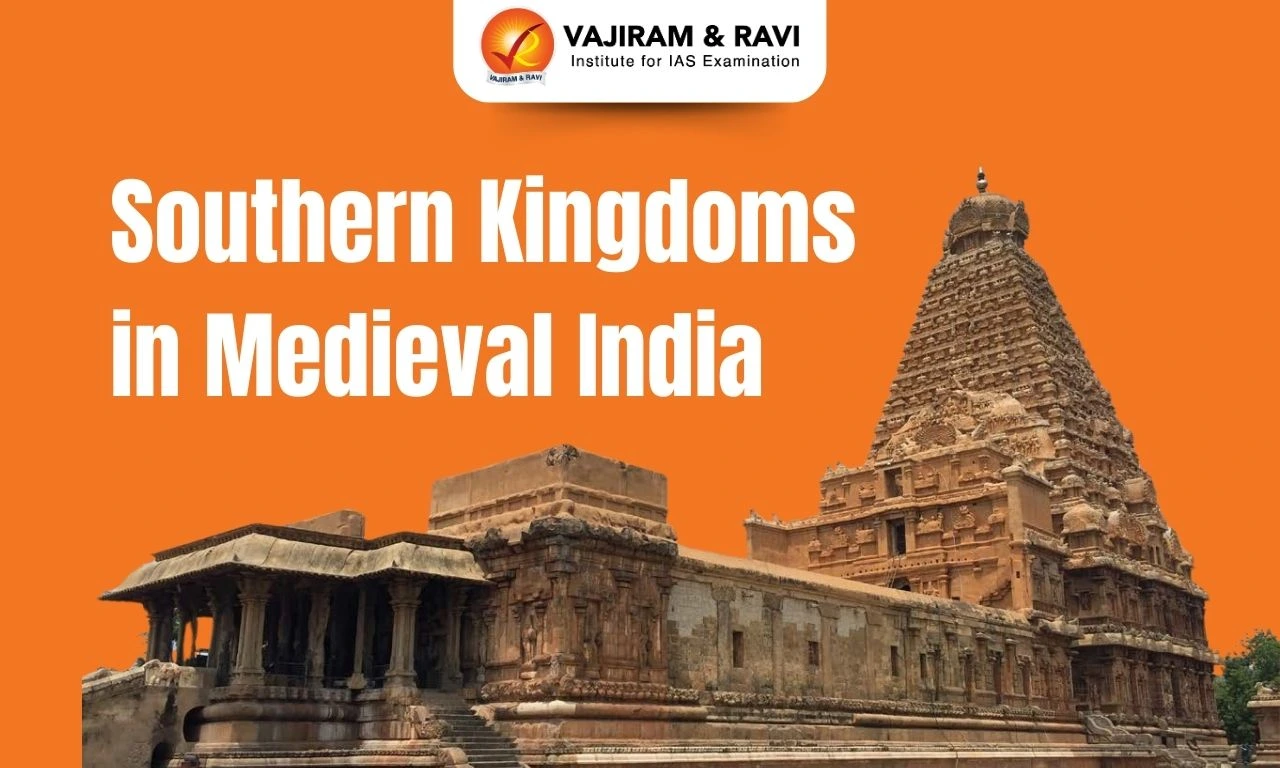Digital economy, driven by internet connectivity, data, and advanced technologies, is reshaping global economic systems. India's digital economy, driven by emerging technologies like artificial intelligence, blockchain, and cloud computing, is expected to add between $355 billion to $435 billion to the country’s GDP by 2025. It is also projected to create around 60 to 65 million jobs.
However, challenges such as the digital divide, data privacy, and cybersecurity remain. As digital services expand, enhancing digital literacy and strengthening cybersecurity will be crucial to sustaining growth and addressing these issues.
Digital Economy Meaning
The term digital economy refers to economic activities enabled by the extensive web of online interactions among individuals, businesses, machines, data, and systems that occur daily. It includes a variety of digital technologies such as the Internet, mobile and sensor networks, cloud computing, artificial intelligence, machine learning, and blockchain.
- Originally coined by Don Tapscott in 1995, the concept has evolved beyond the conventional "internet economy" to include cyber-physical systems that are reshaping sectors such as healthcare, finance, and agriculture.
- As per a report by McKinsey, India's digital economy could create between 60 to 65 million jobs by the year 2025.
- Additionally, the report estimates that the digital sector’s contribution to India’s GDP may rise to $355–435 billion by 2025, significantly up from $200 billion in 2018.
- Key features of the digital economy include:
- Digitisation of Information and Communication.
- Interconnectedness and Network Effects.
- Data-driven decision-making.
- Platform-based business models.
- Rapid innovation and disruption.
Digital Economy Components
The digital economy includes key components like government, infrastructure, telecom, e-business, digital services, and emerging technologies. In India, these are rapidly expanding, fueling the nation's digital transformation.
- Digital Infrastructure: This includes high-speed internet networks, data centers, cloud computing services, and communication technologies that form the backbone of digital interactions.
- E-Commerce Platforms: Online marketplaces and retail platforms facilitate the buying and selling of goods and services, expanding market reach and consumer access.
- Digital Content and Media: Streaming services, online publications, and social media platforms distribute content digitally, influencing consumer engagement and advertising strategies.
- Digital Services: Services delivered through digital means, including online education, telemedicine, and virtual consultations, enhance accessibility and convenience.
- Cybersecurity: Protecting digital assets and information through robust cybersecurity measures is crucial to maintaining trust and integrity in the digital economy.
- Government, Policy, and Regulation: Governments play a critical role by enacting policies and regulatory frameworks that foster innovation, ensure competition, protect consumers, and maintain data privacy. Initiatives like Digital India and data protection laws are examples of enabling digital governance.
- Emerging Technologies: Advanced technologies such as Artificial Intelligence (AI), Blockchain, the Internet of Things (IoT), 5G, and Quantum Computing are foundational to the next phase of digital transformation. They create new business models, automate processes, and increase decision-making precision.
Digital Economy in India
India's digital economy has become a vital pillar of its overall economic landscape. In the fiscal year 2022–23, it contributed approximately 11.74% to the nation's GDP, translating to around INR 31.64 lakh crore (USD 402 billion).
- Employments: This sector is not only expanding rapidly but also demonstrates remarkable efficiency—generating output nearly five times greater per worker compared to the rest of the economy.
- It currently provides employment to about 14.67 million people, accounting for 2.55% of the national workforce.
- Key Drivers: The most significant contributors within the digital economy are the digitally enabling sectors, such as Information and Communication Technology (ICT) services, and the manufacturing of electronics, computer systems, and communication equipment.
- These core segments collectively added about 7.83% to the Gross Value Added (GVA). In addition, digital platforms and online intermediaries contributed another 2% of GVA, reflecting the rising influence of e-commerce, fintech, and digital marketplaces.
- Digital transformation is also making substantial inroads into traditional industries like banking, finance, retail, and education, which together contributed an extra 2% to GVA through digital adoption.
- Potential of India’s digital economy: India’s digital economy is projected to make up 20% of the country’s GVA by 2029–30, surpassing contributions from agriculture and manufacturing.
- Key enablers of this rapid expansion include the growing adoption of artificial intelligence (AI), cloud computing, and the increasing presence of Global Capability Centers (GCCs).
- India now hosts over 55% of the world’s GCCs, which are offshore hubs established by multinational companies to deliver services such as research and development (R&D), IT operations, and business process management for their parent organisations.
Digital Economy Government Initiatives
India has launched several significant initiatives as part of its Digital India program to transform the country into a digitally empowered society and knowledge economy. Here are some major initiatives:
- Digital India Programme: The Digital India Programme, launched in 2015, seeks to build a digitally empowered society and knowledge-based economy by enhancing digital infrastructure and connectivity across the country.
- Unified Payments Interface (UPI): Introduced in 2016, UPI revolutionised digital payments, processing 83% of India’s digital transactions and surpassing global giants in both transaction volume and value by 2025.
- Pradhan Mantri Gramin Digital Saksharta Abhiyan (PMGDISHA): Started in 2017, PMGDISHA has trained over 6 crore rural citizens in digital literacy, equipping them with essential skills for internet use, digital devices, and cashless transactions.
- Startup India: This initiative fosters innovation and entrepreneurship by supporting startups with funding, regulatory ease, and access to digital infrastructure, helping India become a global startup hub.
- National Digital Communication Policy (NDCP) 2018: NDCP 2018 focuses on expanding digital infrastructure, improving broadband connectivity, and promoting advanced technologies like 5G to enhance India’s digital ecosystem.
- National Artificial Intelligence Mission: This mission aims to position India as a leader in AI by promoting research, development, and adoption of artificial intelligence across sectors such as healthcare, agriculture, and education.
State of India’s Digital Economy Report 2025
The State of India’s Digital Economy (SIDE) Report 2025, jointly released by the Indian Council for Research on International Economic Relations (ICRIER) and Dutch investment firm Prosus, offers a comprehensive analysis of India's digital transformation using the CHIPS framework—Connect, Harness, Innovate, Protect, Sustain. Key findings of the report are:
- India ranks as the third-largest digitalised economy globally, trailing only the United States and China. This position reflects the country's expansive digital infrastructure and widespread adoption of digital services.
- The report highlights that India's digital economy is expanding at twice the rate of its overall economy and is projected to contribute 20% to the GDP by 2029.
- However, the report also identifies areas for improvement. India ranks 11th in AI research and 16th in AI infrastructure among 32 countries, indicating a need for enhanced investment and development in artificial intelligence capabilities.
- Furthermore, while India boasts a large number of digital users, the average depth of digital usage remains modest, placing the country eighth in the combined CHIPS ranking. This suggests that while digital services are accessible, their utilisation and impact are not yet uniform across all population segments.
Digital Economy Benefits
The digital economy benefits include productivity, global market access, innovation, financial inclusion, job creation, environmental sustainability, and enhanced public service delivery through e-governance initiatives.
- Increased Productivity: India’s digital economy is nearly five times more productive than traditional sectors, with digital technologies streamlining operations, automating tasks, and boosting efficiency across industries.
- Global Market Access: E-commerce and TradeTech platforms have enabled Indian businesses, especially MSMEs, to access global markets, with the e-commerce sector exports targeting $1 trillion by 2030.
- Innovation and Entrepreneurship: The digital ecosystem lowers entry barriers, fosters innovation, and supports entrepreneurship. India’s start-up count is expected to reach 180,000 by 2030, with $170 billion in cumulative funding by 2025.
- Financial Inclusion: The adoption of digital payment systems, such as the Unified Payments Interface (UPI), has expanded access to banking and credit services, particularly in underserved communities.
- Job Creation: The digital economy generates new job roles and opportunities in emerging technology industries. It added 2.55% of workforce by 2022–23 to India’s economy, including roles in AI and cybersecurity.
- Complementary to Emerging Economies: The digital economy plays a crucial role in advancing the green economy, blue economy, and circular economy by enabling smart resource management, support marine and environmental sustainability.
- Environmental Sustainability: Digital technologies, including Green IT and cloud computing, support sustainable practices by improving resource mobilisation, reducing energy use, and cutting emissions, helping countries achieve Sustainable Development Goals.
Digital Economy Challenges
The digital economy's key challenges include the digital divide, data privacy concerns, job displacement due to automation, regulatory hurdles, market monopolies, rising cybercrime, and the environmental impact of increased energy consumption and e-waste.
- Digital Divide: Despite over 900 million internet users in India by 2025, rural internet penetration remains just 35% compared to 70% in urban areas, perpetuating socio-economic and educational inequalities.
- Data Privacy and Security: India’s Digital Personal Data Protection Act, 2023, mandates explicit consent and data localisation, but rising data breaches and evolving cyber threats highlight ongoing privacy and cybersecurity concerns.
- Job Displacement: AI-driven automation in India could lead to significant job losses, with estimates ranging from 12 to 18 million jobs potentially being affected.
- Regulatory Challenges: India’s digital regulations struggle to keep pace with rapid tech changes; unclear policies on AI, data protection, and content moderation often lead to compliance uncertainty and industry pushback.
- Digital Monopolies: The Competition Commission of India fined Meta ₹213 crore in 2024 for abuse of dominance, reflecting concerns over Big Tech’s market power, anti-competitive practices, and the stifling of innovation.
- Cybercrime: India recorded 65,893 cybercrime cases in 2022, and in the first 10 months of 2024–25 alone, digital financial frauds have led to losses amounting to ₹4,245 crore.
Digital Economy Way Forward
Digital Economy Way Forward involves creating inclusive, secure, and innovation-driven digital ecosystems. It requires strengthening infrastructure, updating policies, bridging skill gaps, and ensuring equitable access to maximise India's digital growth potential.
- Expanding Digital Infrastructure: Continued investment in high-speed internet, 5G networks, and rural connectivity is critical. This ensures that digital services are available even in the most remote areas.
- Enhancing Digital Literacy: Programs aimed at improving digital skills in the population, particularly in rural areas, will be critical. This includes both basic digital skills training and advanced IT and coding training.
- Supporting Startups and Innovation: By providing funding, mentorship, and regulatory support, we can foster innovation in the digital space.
- Strengthening Cybersecurity: As the number of digital transactions and data usage grows, strong cybersecurity measures are required to protect against threats and build user trust.
- Leveraging AI and Big Data: Using artificial intelligence and big data analytics can improve decision-making, service delivery, and drive efficiencies in a variety of industries.
Digital Economy UPSC PYQs
Question 1: What is the status of digitalisation in the Indian economy? Examine the problems faced in this regard and suggest improvements. (UPSC Mains 2023)
Question 2: How can the Digital India program help farmers to improve farm productivity and income? What step has the government taken in this regard? (UPSC Mains 2015)
Question 3: Consider the following statements: (UPSC Prelims 2018)
- Aadhaar card can be used as a proof of citizenship or domicile.
- Once issued, Aadhaar number cannot be deactivated or omitted by the Issuing Authority.
Which of the statements given above is/are correct?
(a) 1 only
(b) 2 only
(c) Both 1 and 2
(d) Neither 1 nor 2
Answer: (d)
Last updated on December, 2025
→ Check out the latest UPSC Syllabus 2026 here.
→ Join Vajiram & Ravi’s Interview Guidance Programme for expert help to crack your final UPSC stage.
→ UPSC Mains Result 2025 is now out.
→ UPSC Notification 2026 is scheduled to be released on January 14, 2026.
→ UPSC Calendar 2026 is released on 15th May, 2025.
→ The UPSC Vacancy 2025 were released 1129, out of which 979 were for UPSC CSE and remaining 150 are for UPSC IFoS.
→ UPSC Prelims 2026 will be conducted on 24th May, 2026 & UPSC Mains 2026 will be conducted on 21st August 2026.
→ The UPSC Selection Process is of 3 stages-Prelims, Mains and Interview.
→ UPSC Result 2024 is released with latest UPSC Marksheet 2024. Check Now!
→ UPSC Prelims Result 2025 is out now for the CSE held on 25 May 2025.
→ UPSC Toppers List 2024 is released now. Shakti Dubey is UPSC AIR 1 2024 Topper.
→ UPSC Prelims Question Paper 2025 and Unofficial Prelims Answer Key 2025 are available now.
→ UPSC Mains Question Paper 2025 is out for Essay, GS 1, 2, 3 & GS 4.
→ UPSC Mains Indian Language Question Paper 2025 is now out.
→ UPSC Mains Optional Question Paper 2025 is now out.
→ Also check Best IAS Coaching in Delhi
Digital Economy FAQs
Q1. What is meant by digital economy?+
Q2. What are the three main components of the digital economy?+
Q3. How important is digital economy?+
Q4. What is current digital economy?+
Q5. Is India a digital economy?+

















